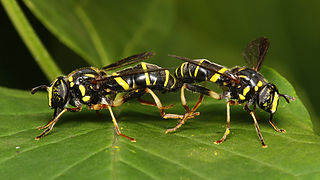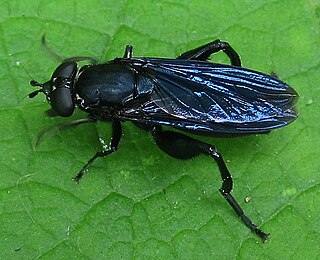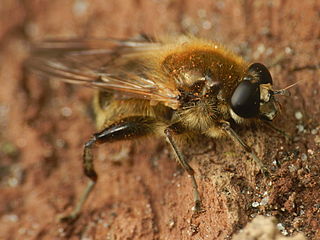
Mallota is a widely distributed Holarctic genus of hoverfly, well known for their bee-like appearance.

Xylota is a Holarctic genus of hoverflies similar in structure to the related genera Chalcosyrphus and Brachypalpoides. As the larvae are saprophytic they're usually found in rotting wood. The adult flies are generally associated with woodland and woodland edges and can often be seen running over the upper sides of leaves. Unlike other syrphids the adults of many species rarely visit flowers preferring instead to gather pollen from leaf surfaces. There are over 100 described species of which 12 can be found in Europe. Seven species have been recorded in Britain. Identification of species has been difficult and identifiction by photographs is risky.

Spilomyia is a genus of hoverflies. Many species in the genus show Batesian mimicry of wasp models, including black and yellow patterns and modified antenna shape.

Platycheirus is a large genus of hoverflies. They are also called sedgesitters.

Criorhina is a genus of hoverflies. Medium to large sized species, black or greenish black, with or without light ground markings mimicking bumblebees. The head is much flattened and broader than the thorax. The antennae are situated upon a prominent conical frontal process, The face is moderately produced below the eyes, downward or forward, in profile. The eyes are bare. The abdomen is elliptical or very short oval. Larvae found in rot holes or decaying hardwoods

Blera is primarily a North American genus, though there are 3 species from Europe. The genus is characterized by the following characters:

Chalcosyrphus is a genus of hoverflies in the subfamily Eristalinae. Many species exhibit some degree of mimicry of various sawflies and other hymenopterans and are often brightly coloured or metallic in hue. The adults are similar in structure and behavior to the related genus Xylota but differ in larval morphology. They can be found throughout Europe, Asia, and North America and seem to prefer damper, boggy habitats. The larvae are saproxylic feeders in rotten wood in these habitats.

Brachyopa is a Holarctic genus of hoverflies whose grey and brown colouration is unusual for this family and these flies can easily be overlooked amongst members of other fly families. The larvae can be found under the bark of dead branches and trees in decaying sap.

These are small black and yellow or mostly black flies with a narrow abdomen near the thorax. They occur mainly in damp places among low herbage. The larva of Neosascia are flattened without oral hooks and a have a short posterior spiracular process or "tail" rat-tailed that is saprophagous. In 1925 Curran reviewed the genus Neoascia. In this work a key is provided and ten species are described including four new species some of which have later been determined to be synonyms.

Brachypalpus is a genus of hoverflies, from the family Syrphidae, in the order Diptera. The head is triangular and produced well forwards and somewhat downwards. The thorax and abdomen with pile often rather long. The hind femur is swollen and with an obtuse spur apically and ventrally. The hind trochanters of male is spurred.
The larvae are of the rat-tailed type feeding on decaying sap under tree bark. Larvae live in decaying trees and logs. Larva and pupa have been described by Malloch.
Sphegina (Asiosphegina) brevipilus is a species of hoverfly in the family Syrphidae found in China. It's similar to both S. (A.) plautus and S. (A.) simplex; it and S. (A.) plautus are the only known species with a sclerite between the bases of surstyli as well as posteriorly from the cerci.
Sphegina crinita is a species of hoverfly in the family Syrphidae found in Malaysia and Indonesia. It's easily identified by its superior lobes, the left side one being pushed over the medial line of the hypandrium to the right side so that the right side one seems bilobed. Otherwise, the genitalia are nearly identical to those in S. fimbriata.
Sphegina karnataka is a species of hoverfly in the family Syrphidae.
Sphegina setosa is a species of hoverfly in the family Syrphidae.
Sphegina (Asiosphegina) amamiensis is a species of hoverfly in the family Syrphidae found in Japan. It is easily identified by the wide bifid lobe on the male sternum IV which is located on the right side; in most other species it is located on the left.
Sphegina kumaoniensis is a species of hoverfly in the family Syrphidae found in India, Thailand, and northeast Myanmar. It's characterized by a convex dorsal line of frontal prominence that ends clearly before the ocellar triangle as well as a mouthedge less strongly projecting, vibrissal angle less protruding or equal with the frontal prominence.
Sphegina quadrisetae is a species of hoverfly in the family Syrphidae found in China. It's characterized by the long black pile posterior of the posteromedial corner of the eye, the scutellum with four long black setae at posterior margin, and the black and extremely strongly antero-ventrally projected face.
Sphegina hansoni is a species of hoverfly in the family Syrphidae.
Sphegina philippina is a species of hoverfly in the family Syrphidae.
Asiosphegina is a subgenus of hoverflies characterized by sternite I being narrow and lanceolate, several times longer than wide or membranous, and non-pilose, as well as the postmetacoxal bridge being broad, it's posterior margin almost straight, at most with small triangular medial incision.










